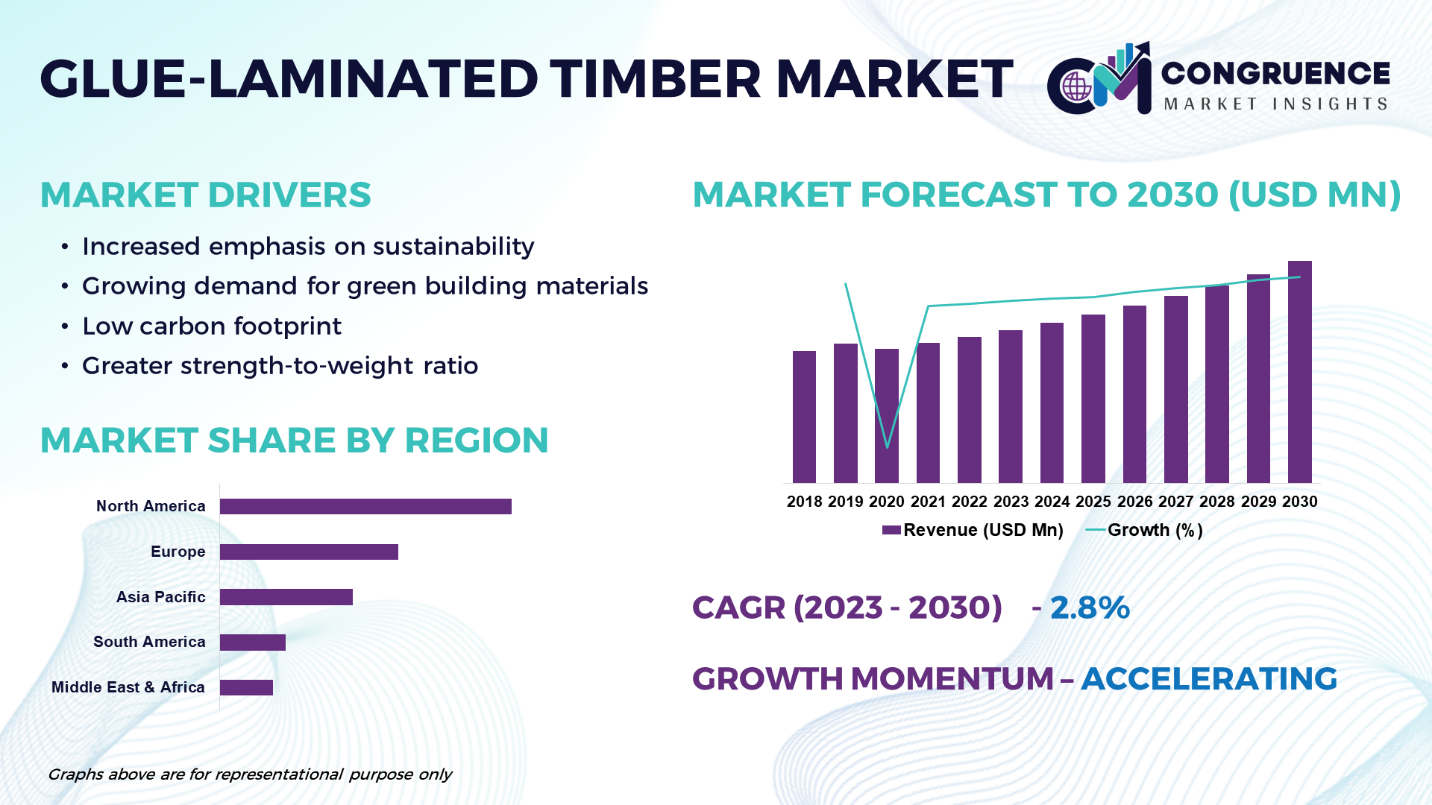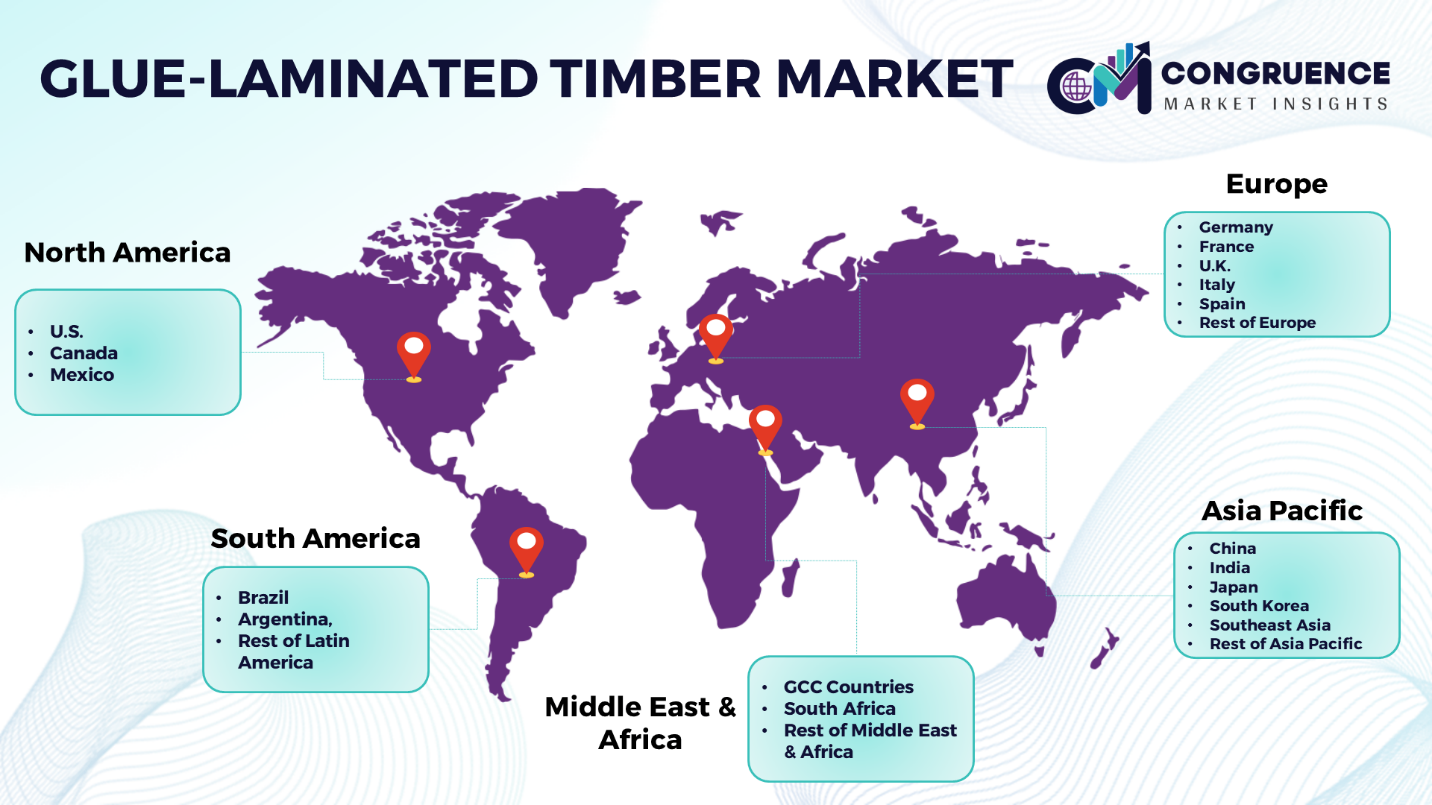Reports
The Global Glue-Laminated Timber Market is expected to expand at a CAGR of 2.8% between 2023 and 2030. Glue-laminated timber, commonly known as glulam, is an engineered wood product used extensively in construction and architectural applications. It is created by bonding together individual layers of dimensioned lumber using high-strength adhesive, typically with the grain of all layers’ parallel. This process results in a versatile and strong structural material with a wide range of applications. Glulam offers several advantages, including superior load-bearing capabilities, resistance to warping and cracking, and the ability to span long distances. It is environmentally friendly as it utilizes sustainably harvested timber. Glulam's versatility and strength make it a popular choice for beams, columns, and arches in various building projects, including residential, commercial, and industrial construction. In recent years, there has been a rise in demand for wood building. This is mostly due to the fact that people are becoming more conscious of environmental problems including global warming and the diminishing supply of petroleum and natural gas, as well as due to adhesive technologies are being supported, allowing wood to be utilized for challenging and novel construction projects. This provides a plethora of options when selecting glue-laminated wood for different purposes.

Glue-Laminated Timber Market Major Driving Forces
Increased Emphasis on Sustainability: The growing emphasis on sustainability and environmental consciousness in the building industry is one of the main drivers driving the expansion of the worldwide glue-laminated timber business. Since trees in sustainably managed forests are replanted as they are harvested, glue-laminated lumber comes from a sustainable and environmentally benign supply of raw materials.
Growing Demand for Green Building Materials: Glulam's eco-friendly qualities make it a desirable option for architects and construction professionals as environmental rules and customer preferences continue to emphasize the use of green building materials.
Low Carbon Footprint: Glue-laminated timber has a lower carbon footprint than conventional building materials such as steel or concrete, which is in line with the global effort to reduce greenhouse gas emissions and mitigate climate change.
Greater Strength-To-Weight Ratio: The strength-to-weight ratio of glue-laminated wood is higher than that of many conventional construction materials, enabling effective load-bearing capabilities. This natural strength allows builders and architects to produce creative and economical structural designs.
Glue-Laminated Timber Market Key Opportunities
Eco-Friendly and Sustainable Options: The glue-laminated wood industry has a potential to create and promote sustainable choices due to the growing demand for eco-friendly products. As the global glue-laminated wood market expands, one of the primary potential opportunities for the producers is the increased emphasis on sustainability and environmental consciousness in the building sector.
Growing Urbanization and Population Growth: The persistent worldwide tendency of urbanization, in conjunction with population expansion, has resulted in a heightened need for economical and effective building methods. Glue-laminated wood is essential to satisfying these requirements.
Stringent Regulations: Around the world, strict building norms and laws pertaining to construction safety have gained traction. Many of these criteria, including fire and earthquake resistance, are satisfied by glue-laminated wood, which makes it a good option in locations with stringent safety regulations or those vulnerable to natural catastrophes.
Glue-Laminated Timber Market Key Trends
· Glue-laminated timber (GLT) being more widely used as a sustainable substitute for conventional construction materials.
· Increasing demand for items made of engineered wood because of its improved structural qualities and visual attractiveness.
· Use of glulam in areas other than standard structural parts, such as interior design and architectural aspects.
· Growing need for prefabricated glulam components in order to save money and speed up construction.
· Innovation in manufacturing techniques and bonding technologies to improve the effectiveness and performance of the final product.
· The focus on carbon sequestration and sustainability is propelling government support and commercial expansion.
· Combining parametric modeling with digital design techniques to increase material savings and optimize glulam structures.
· Working together, developers, architects, and manufacturers may explore new uses and push the limits of glulam design and construction.

Market Competition Landscape
The market for glue-laminated timber is very competitive, with both well-established firms and up-and-coming competitors. Prominent corporations exhibit a noteworthy presence in the market owing to their broad manufacturing capacities, well-established distribution networks, and varied range of products, encompassing glulam grades and dimensions customized to cater to distinct building requirements. Furthermore, the ongoing emphasis on research and development initiatives drives market competitiveness. Major businesses are making innovative investments to improve glue-laminated wood products' quality and performance in an effort to satisfy changing consumer needs and strict construction codes. In addition, firms are increasingly forming strategic alliances and collaborations in an effort to penetrate new markets and broaden their worldwide reach. Furthermore, these companies frequently use mergers, acquisitions, and regional growth as tactics to strengthen their standing within the business. Prominent players in the market include:
· Boise Cascade Company
· Binderholz GmbH
· Mayr-Melnhof Holz Holding AG
· Stora Enso Oyj
· Structurlam Mass Timber Corporation
· Pfeifer Group
· Setra Group AB
· Rubner Holzbau GmbH
· Hasslacher Holding GmbH
· KLH Massivholz GmbH
· HASSLACHER Group
· Schilliger Holz AG
· Holzwerke Ladenburger GmbH
· Ed. Züblin AG
· Nordic Structures Inc.
|
Report Attribute/Metric |
Details |
|
Base Year |
2022 |
|
Forecast Period |
2023 – 2030 |
|
Historical Data |
2018 to 2022 |
|
Forecast Unit |
Value (US$ Mn) |
|
Key Report Deliverable |
Revenue Forecast, Growth Trends, Market Dynamics, Segmental Overview, Regional and Country-wise Analysis, Competition Landscape |
|
Segments Covered |
· By Product Type (Glulam Beams, Glulam Columns, Glulam Trusses, Others) · By Application (Residential Construction, Commercial Construction, Industrial Construction, Infrastructure) · By End-user (Builders & Contractors, Architects & Designers, Manufacturers, Others) |
|
Geographies Covered |
North America: U.S., Canada and Mexico Europe: Germany, France, U.K., Italy, Spain, and Rest of Europe Asia Pacific: China, India, Japan, South Korea, Southeast Asia, and Rest of Asia Pacific South America: Brazil, Argentina, and Rest of Latin America Middle East & Africa: GCC Countries, South Africa, and Rest of Middle East & Africa |
|
Key Players Analyzed |
Boise Cascade Company, Binderholz GmbH, Mayr-Melnhof Holz Holding AG, Stora Enso Oyj, Structurlam Mass Timber Corporation, Pfeifer Group, Setra Group AB, Rubner Holzbau GmbH, Hasslacher Holding GmbH, KLH Massivholz GmbH, HASSLACHER Group, Schilliger Holz AG, Holzwerke Ladenburger GmbH, Ed. Züblin AG, Nordic Structures Inc. |
|
Customization & Pricing |
Available on Request (10% Customization is Free) |
